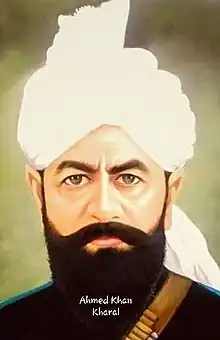Rai Ahmad Khan Kharal
Rai Ahmad Khan Kharal (Punjabi: رائے احمد خان کھرَل; c. 1776 – 21 September 1857),[1][2] widely known as Nawab of Jhamra,[1][3] was a Punjabi Muslim chieftain of the Kharal tribe. He led rebellion in the Bar region of Punjab against the British East India Company in the War of Independence of 1857 and died fighting against it on 21st of September, 1857, at the age of 81.[4][3][5] He is today considered a folk hero in Punjab.[6]
Rai Ahmad Khan Kharal | |
|---|---|
رائے احمد خاں کھرل | |
 | |
| Born | 1776 |
| Died | 21 September 1857 (aged 80–81) |
| Cause of death | Killed in battle |
| Monuments | Tomb of Rai Ahmad Khan Kharal |
| Other names | Nawab of Jhamra |
| Known for | Freedom fighter |
| Parents |
|
Biography
Rai Ahmad Khan Kharal was born into a rich landowning family of the Kharal[7] clan in the Sandal Bar region of Punjab, in Chak 434 Gb Jhamra village 23 km from Tandlianwala Faisalabad District and 57 km from Faisalabad city.
He was the de facto ruler of Jhamra, he possessed large sum of land and cattle. He was respected by all Kharals as well as other tribes such as Kathia, Wattoo, Fatayana and others. Rai Kharal had influence over all of Sandal Bar.[8]
Lord Berkley (or, in local language, Berkeley), who was the extra Assistant Commissioner of Gogera, called out all important personalities of the area, and Rai Ahmed Khan Kharal came. Berkley demanded all the leaders to supply men and horses to crush the revolt. On this, Rai Ahmed Khan Kharal said "Kharals do not share wife, horse and land with anyone" and left.[9]
Role in War of Independence (1857)
On July 8, British arrested a large number of Joiya tribe's men, women and children after they refused to pay the heavy taxes (Lagan).[8] When Rai Kharal received the news he planned to break into the Gogera jail and rescue the innocent people imprisoned there. With help of his Fatayana, Wattoo and Kathia friends Rai Ahmed attacked the Gogera Jail on July 26. According to British records 17 prisoners were killed, 33 were injured and 18 fled.[10][11] But native accounts disagree saying 145 prisoners died and 100+ EIC troops were also killed.[12] British arrested Rai Ahmed but released him due to pressure from other tribes and as no proper evidence was available against him.[8] Rai Ahmed Khan Kharal didn't stop and continued rebellion against Britain. In order to arrest Rai Ahmed Khan Kharal, Berkley attached Jhamra but was unable to arrest Rai Kharal although he imprisoned 20 civilians and took with himself a large sum of cattle.[8] Rai Ahmed Khan Kharal with help of Kathia, Wattoo, Fatayana and Joiya tribe started a guerilla campaign against British. According to Punjab government records the rebels numbered 20,000 to 30,000 men.[11] According to John Cave-Browne book each time, these rebels took refuge in thick jungles and grass and attacked with 3000-5000 guerillas, the sound of drum beating was the sign that they would attack.[13] The connection of Jhang to Lahore was completely cut. Rai Ahmed Khan Kharal planned a final attack on Gogera but the information was leaked by Sarfraz Kharal of Kamalia, British were ready to face any attack and when rebels attacked they were repulsed.[8]
Rai Ahmed with his companions fled to Jungles of Gashkori, British got news about it and a force under Captain Black was sent to kill him, they succeeded in killing him while he was offering afternoon prayers.[8][13] Many of his close companions such as Sarang Khan Kharal of Begeke Kharals also died there.[13]
A trusted partner of Rai Ahmed Khan Kharal, Murad Fatayana took revenge of him by killing Lord Berkley alongside 50 british and native troops and became Rai's successor leading the rebellion until it ended in 1858 as local tribes lost.[8][13][14][12]

See also
References
- "Ahmed Khan Kharal and the Raj". www.thenews.com.pk. Retrieved 2021-09-20.
- "Past in Perspective". The Nation. 2019-06-25. Retrieved 2021-09-20.
- "Kharal and Berkley II". DAWN.COM. 22 April 2013. Retrieved 2020-05-07.
- "Ahmed Khan Kharal and the Raj". thenews.com.pk. Retrieved 2020-05-07.
- "Past in Perspective". nation.com.pk. 25 June 2019. Retrieved 2020-05-07.
- "Punjab University: Rai Ahmad Khan Kharral (Myth or Reality)". Retrieved 2022-11-22.
- "Kharal and Berkley II". 22 April 2013.
- Saranga, Turab ul Hasan (2020). Punjab and the War of Independence 1857-1858 from Collaboration to Resistance (1st ed.). Oxford, England: Oxford University Press. ISBN 9780190701840.
- Miraj, Muhammad Hassan (2013-04-15). "Kharal and Berkley". DAWN.COM. Retrieved 2022-09-24.
- General Report on the Administration of the Punjab Territories, from 1856-57 to 1857-58 Inclusive: Together with a Brief Account of the Administration of the Delhi Territory, from the Re-occupation of Delhi Up to May 1858. Printed at the Chronicle Press, by Mahomed Azeem. 1854.
- Punjab (1911). Government Records: Mutiny records. Correspondence and reports. Punjab Government Press.
- "Tributes to A.D. Aijaz, the oral historian of Kharal's resistance - Newspaper". DAWN.COM. 8 July 2019. Retrieved 2020-05-07.
- Cave-Browne, John (1861). The Punjab and Delhi in 1857: Being a Narrative of the Measures by which the Punjab was Saved and Delhi Recovered During the Indian Mutiny. William Blackwood and Sons.
- Saeed Ahmed Butt (2015). "Rai Ahmad Khan Kharral (Myth or Reality)" (PDF). Journal of the Punjab University Historical Society. 28 (2): 173–191. Retrieved 2020-05-07.